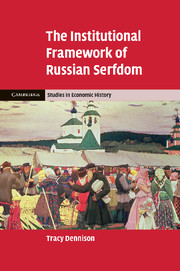Book contents
- Frontmatter
- Contents
- List of figures and tables
- Preface
- A note on the value of the rouble
- A note on transliteration
- List of abbreviations
- Glossary
- Map: Yaroslavl' and surrounding provinces
- 1 Why is Russia different? Culture, geography, institutions
- 2 Voshchazhnikovo: a microcosm of nineteenth-century Russia
- 3 Household structure and family economy
- 4 The rural commune
- 5 Land and property markets
- 6 Labour markets
- 7 Credit and savings
- 8 Retail markets and consumption
- 9 The institutional framework of Russian serfdom
- Bibliography
- Index
2 - Voshchazhnikovo: a microcosm of nineteenth-century Russia
Published online by Cambridge University Press: 03 May 2011
- Frontmatter
- Contents
- List of figures and tables
- Preface
- A note on the value of the rouble
- A note on transliteration
- List of abbreviations
- Glossary
- Map: Yaroslavl' and surrounding provinces
- 1 Why is Russia different? Culture, geography, institutions
- 2 Voshchazhnikovo: a microcosm of nineteenth-century Russia
- 3 Household structure and family economy
- 4 The rural commune
- 5 Land and property markets
- 6 Labour markets
- 7 Credit and savings
- 8 Retail markets and consumption
- 9 The institutional framework of Russian serfdom
- Bibliography
- Index
Summary
The Voshchazhnikovo estate was given to Field Marshal Boris Petrovich Sheremetyev in 1706 by Peter the Great as a reward for outstanding service during the Great Northern War with Sweden (1700–21). The Sheremetyev family, who descended from a long line of Muscovite aristocrats, was one of the largest landholding families in Russia. Boris Petrovich Sheremetyev had already acquired several estates through inheritance and military service by the time he was given the Voshchazhnikovo holding. By 1708, he held nineteen estates in at least seven different provinces, on which lived approximately 40,000 serfs. The family's holdings were expanded by his son, Pyotr Borisovich, who, through marriage, purchase, and service to the crown, acquired a number of additional holdings. By 1765, the Sheremetyevs held over thirty estates in seventeen provinces and roughly 170,000 serfs. This expansion continued into the next century, so that by the time serfdom was abolished in 1861, the Sheremetyev family held some 300,000 serfs. These holdings put the Sheremetyevs – along with other families such as the Gagarins, Iusupovs, Vorontsovs, and Orlovs – among that small group of landholders, who, although they comprised only 1 per cent of total landholders in Russia, held over 30 per cent of the serf population.
The Voshchazhnikovo estate was located in Yaroslavl' province, in the Central Industrial Region of European Russia. A number of important towns were established here in the early medieval period, including Yaroslavl', Vladimir, Moscow, and Nizhnyi Novgorod.
- Type
- Chapter
- Information
- The Institutional Framework of Russian Serfdom , pp. 29 - 49Publisher: Cambridge University PressPrint publication year: 2011



